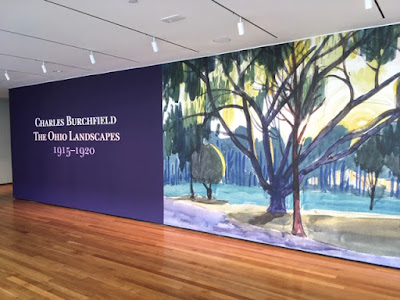Cleveland Museum of Art's Burchfield Exhibition, Part 1
It was Charles Burchfield's small Ohio hometown of Salem that first propelled his leap into his vivid fantasy world we know from his paintings.
I've long felt a kinship with Burchfield. I made the decision to become a painter while studying at Oberlin College, only a few miles from Burchfield's Salem. Like him I (briefly) attended the Cleveland Institute of Art (Cleveland School of Art in his day) and frequently visited the collections of the Cleveland Museum of Art that he knew well.
I flew to Cleveland to catch the exhibition at the Cleveland Museum of Art (CMA) Charles Burchfield: The Ohio Landscapes 1915-1920 shortly before it closed in early May. Organized by Britany Salsbury, one of the new curators at the Museum, the show draws both on the CMA's collection and loaned works from the Burchfield Penney Art Center in Buffalo.
Charles Burchfield, Church Bells Ringing,
Rainy Winter Night, watercolor, 1917,
Cleveland Museum of Art
Undoubtedly the "star" of CMA's Burchfields is the magnificently creepy Church Bells Ringing, Rainy Winter Night. Burchfield is famous for imbuing a living personality into the buildings he painted. In this one the church spire seems transformed into a menacing creature. There's potential danger in putting the suggestion of a face into architecture. Poorly done it might be the only thing our eye would focus on and could come off as corny or childish. Burchfield counteracts this by inventing accompanying shapes for the sides of the buildings that mimic the angular forms in the face-like spire. The fantastic "face" fits seamlessly into a world of fantastic forms.
Detail- Church Bells Ringing
Though I'd seen reproductions of this painting for years, Salsbury's wall text pointed out an unexpected detail (above) I'd alway missed- a tiny note of a cheerful colorful Christmas tree glimpsed through the window of an adjoining house.
Another wall text and photo reveal the way Salem's Baptist church steeple echoes the shapes in Burchfield's invented face-like spire.
Hillside from 1917, is seemly one of his most empty and unpopulated compositions. For me Burchfield's greatest accomplishment is how he convinces us that his forms are energetically moving, or are likely to start at any moment. In the foreground long grasses bend this way and that. The overall lightly painted fields are punctuated by just enough dark accents (are they rocks?, shadows?) to serve as stepping stones to move our eye into the deep space.
Charles Burchfield, Hillside, watercolor,
1917, Cleveland Museum of Art
One of my jobs when I was a boy was hauling the family Christmas tree out into the woods once the holiday was over, so I'm predisposed to like the painting below. Nonetheless its balance of a nearly empty foreground contrasting the busy layers of backyards and houses in the painting's top half is beautifully realized.
Charles Burchfield, Backyards in Winter (Castoff Christmas Tree),
watercolor, 1917, Cleveland Museum of Art
Detail- Backyards in Winter
Much of the fun of Burchfield's houses is his way of inserting gesturing movement where you'd least expect it. Salsbury hung these two house paintings side by side in the gallery. Each structure sags and leans in ways we know are impossible yet that we want to believe. This pair of watercolors was my favorite part of the show.
Charles Burchfield, New Moon, watercolor, 1917
Cleveland Museum of Art
Charles Burchfield, New Moon in January, watercolor
1918, Burchfield Penney Art Center, Buffalo, NY
I shared some more photos and observations about the exhibition in a second blog post.











